Posted 9:24 a.m. Thursday, Sept. 8, 2016

Gallery opens with contemporary art about native peoples
Gallery opens with contemporary art about native peoples
The UWL University Art Gallery season opens with a traveling exhibition that explores the historic forced removal of plains peoples in the U.S. Southeast. [caption id="attachment_46694" align="alignright" width="150"]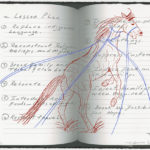 Michael Connors, Lesson Plan, 2013, digital print[/caption]
“Re-Riding History: From the Southern Plains to the Matanzas Bay” opens with a reception from 4-6 p.m. Friday, Sept. 9, in the gallery located on the first floor of the Center for the Arts. The exhibit runs through Sunday, Sept. 25.
The traveling exhibition of contemporary works on paper combines various printmaking methods with drawing, collage and photography. Artists represented include: Jaune Quick-to-See Smith, Shan Goshorn, Mel Chin, Jim Denomie, Edgar Heap of Birds, Alison Saar and Monte Yellow Bird, Sr. Molly Murphy Adams and Dyani White Hawk incorporate traditional Native arts of quill and bead work.
[caption id="attachment_46696" align="alignright" width="150"]
Michael Connors, Lesson Plan, 2013, digital print[/caption]
“Re-Riding History: From the Southern Plains to the Matanzas Bay” opens with a reception from 4-6 p.m. Friday, Sept. 9, in the gallery located on the first floor of the Center for the Arts. The exhibit runs through Sunday, Sept. 25.
The traveling exhibition of contemporary works on paper combines various printmaking methods with drawing, collage and photography. Artists represented include: Jaune Quick-to-See Smith, Shan Goshorn, Mel Chin, Jim Denomie, Edgar Heap of Birds, Alison Saar and Monte Yellow Bird, Sr. Molly Murphy Adams and Dyani White Hawk incorporate traditional Native arts of quill and bead work.
[caption id="attachment_46696" align="alignright" width="150"]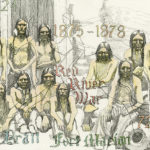 Tony Tiger, Dreaming of Liberty, 2014, Mixed media: color pencil, ink and graphite on watercolor paper[/caption]
The exhibition, curated by Emily Arthur, Marwin Begaye and John Hitchcock, chronicles the journey of 72 American Indians – Cheyenne, Kiowa, Comanche Arapaho and Caddo – who were taken from their homes in Oklahoma and transported by train to St. Augustine. There, they where they were imprisoned at Fort Marion (the present-day Castillo de San Marcos) from 1875-1878.
The removal was part of the federal off-reservation boarding school policy that remained in place in the U.S. until the 1930s. Lt. Richard Henry Pratt commanded Fort Marion at the time and established schools that prohibited Native American children from speaking their languages or practicing their religion. Children were removed from families and suffered what is now understood to be cultural genocide. In 1879, Pratt took over the Carlisle Indian School in Pennsylvania where he continued using these methods to assimilate 530 Chiricahua Apache men, women, and children, all held as prisoners of war. Here, Pratt coined the phrase, “Kill the Indian, save the man.”
[caption id="attachment_46692" align="alignright" width="150"]
Tony Tiger, Dreaming of Liberty, 2014, Mixed media: color pencil, ink and graphite on watercolor paper[/caption]
The exhibition, curated by Emily Arthur, Marwin Begaye and John Hitchcock, chronicles the journey of 72 American Indians – Cheyenne, Kiowa, Comanche Arapaho and Caddo – who were taken from their homes in Oklahoma and transported by train to St. Augustine. There, they where they were imprisoned at Fort Marion (the present-day Castillo de San Marcos) from 1875-1878.
The removal was part of the federal off-reservation boarding school policy that remained in place in the U.S. until the 1930s. Lt. Richard Henry Pratt commanded Fort Marion at the time and established schools that prohibited Native American children from speaking their languages or practicing their religion. Children were removed from families and suffered what is now understood to be cultural genocide. In 1879, Pratt took over the Carlisle Indian School in Pennsylvania where he continued using these methods to assimilate 530 Chiricahua Apache men, women, and children, all held as prisoners of war. Here, Pratt coined the phrase, “Kill the Indian, save the man.”
[caption id="attachment_46692" align="alignright" width="150"]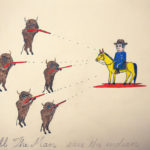 Jenny Schmid, Kill the Man, Save the Indian, 2014, pencil on paper[/caption]
“Re-Riding History” explores the experience of imprisonment through the eyes of contemporary Native and non-Native American artists. Some are descendants of ancestors who were imprisoned during Pratt's tenures. The artists used the format of historic ledger drawings made at Fort Marion from 1875–1878, as well as their heartfelt response and present perspective to this devastating historical experience.
All of the works are the same size as ledger pages. Using ledger has roots in Plains hide paintings recording battle scenes or hunting feats.
[caption id="attachment_46691" align="alignright" width="150"]
Jenny Schmid, Kill the Man, Save the Indian, 2014, pencil on paper[/caption]
“Re-Riding History” explores the experience of imprisonment through the eyes of contemporary Native and non-Native American artists. Some are descendants of ancestors who were imprisoned during Pratt's tenures. The artists used the format of historic ledger drawings made at Fort Marion from 1875–1878, as well as their heartfelt response and present perspective to this devastating historical experience.
All of the works are the same size as ledger pages. Using ledger has roots in Plains hide paintings recording battle scenes or hunting feats.
[caption id="attachment_46691" align="alignright" width="150"]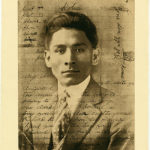 Bobby C. Martin, Pursuit of Civilization # 5, 2014, photo intaglio[/caption]
As bison disappeared and tribes were forced into reservations and internment camps, native artists used government-issued ledger paper instead of materials used earlier.
All University Gallery exhibitions and events are free and open to the public. Regular gallery hours are noon-8 p.m. Mondays-Thursdays, noon-5 p.m. Fridays and Saturdays, by appointment, and during events in Toland Theater. For more information, contact the Art Department at 608.785.8230.
If you go—
What: “Re-Riding History: From the Southern Plains to the Matanzas Bay”
[caption id="attachment_46693" align="alignright" width="150"]
Bobby C. Martin, Pursuit of Civilization # 5, 2014, photo intaglio[/caption]
As bison disappeared and tribes were forced into reservations and internment camps, native artists used government-issued ledger paper instead of materials used earlier.
All University Gallery exhibitions and events are free and open to the public. Regular gallery hours are noon-8 p.m. Mondays-Thursdays, noon-5 p.m. Fridays and Saturdays, by appointment, and during events in Toland Theater. For more information, contact the Art Department at 608.785.8230.
If you go—
What: “Re-Riding History: From the Southern Plains to the Matanzas Bay”
[caption id="attachment_46693" align="alignright" width="150"]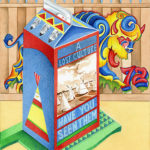 Katherine Liontas B. Warren, A Lost Culture, 2014, watercolor and color pencil[/caption]
Who: Works by Jaune Quick-to-See Smith, Shan Goshorn, Mel Chin, Jim Denomie, Edgar Heap of Birds, Alison Saar and Monte Yellow Bird, Sr.
When: Opens with a reception from 4-6 p.m. Friday, Sept. 9. Exhibit runs through Sunday, Sept. 25
Where: University Art Gallery, UWL Center for the Arts
Admission: Free
Katherine Liontas B. Warren, A Lost Culture, 2014, watercolor and color pencil[/caption]
Who: Works by Jaune Quick-to-See Smith, Shan Goshorn, Mel Chin, Jim Denomie, Edgar Heap of Birds, Alison Saar and Monte Yellow Bird, Sr.
When: Opens with a reception from 4-6 p.m. Friday, Sept. 9. Exhibit runs through Sunday, Sept. 25
Where: University Art Gallery, UWL Center for the Arts
Admission: Free
